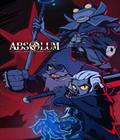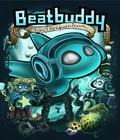Beatbuddy: Tale of the Guardians is a puzzle adventure title for the PC that makes use of the in-game soundtrack to breathe life into the fictional world of Symphonia, which you'll explore across multiple stages. You control Beat, one of the titular guardians, a blue gelatinous blob-like creature that's awakened from a deep slumber to combat the rhythmically challenged Prince Maestro, who threatens the well-being of the musical planet.
The first thing that'll strike you is how gorgeous Beatbuddy looks. The background and foreground elements that comprise the watery environments are fantastically rendered. There's a great opening sequence in the first stage that has you emerging from hibernation and exiting the long-forgotten remains of a gigantic subaquatic creature. The stage name that corresponds with the level music slowly fades in and out. Each song featured is unique for every stage, with various artists providing the wildly eclectic themes throughout Beatbuddy.
Thankfully, considering how much the title focuses on music, the soundtrack is great from beginning to end. I'm not familiar with all of the artists, but from the work sampled within Beatbuddy, I'm certainly interested in hearing more from them. The real treat is seeing how the music interacts with the world of Symphonia and watching how enemies bob and weave with the beat while the character of Beat does the same as he propels through the world.
Being able to catch the rhythm of the different music tracks is key to survival. The more dangerous aspects of the environment involve various barriers that switch from passable material you can glide through to harmful substances that'll damage Beat when hit. You'll need to listen closely to the music to pick up on the right moment to move, which can take some getting used to. If you're rhythmically challenged, Beatbuddy will often be frustrating, but I thought the developers did a pretty solid job of easing in new players. By the time you hit the fourth stage, you'll need to have a firm grasp of moving in accordance with the beat, but by that point, it'll feel like second nature.
With the controls, you have two options: keyboard or standard controller. I attempted my initial playthrough with the keyboard and had a heck of a time getting accustomed to things. Switching to a traditional Xbox 360 controller felt pretty natural, and for me, it was the best way to play through Beatbuddy. The game menus and button prompts definitely seem to be tailored toward an Xbox 360 controller, so I'd definitely suggest the controller over the keyboard.
From a performance perspective, you'll find Beatbuddy isn't very reliant on hardware. On a mid-range gaming laptop, I didn't experience any performance issues, screen tearing or frame rate problems, so even moderate systems should be able to run Beatbuddy.
While a good portion of the gameplay in Beatbuddy involves traversing rhythm-based environments, there's a fair amount of puzzle-solving, too. My biggest complaint is that the puzzles are awfully repetitive, with the majority entailing rotating mirror-like objects that Beat can bounce off when rocketed from the rocky pustules located on the walls and floors of different stages.
These are typically used to put Beat's trajectory on course to bust through walls, so the player must line up multiple rotating mirrors to get from point A to point B. These aren't particularly difficult to figure out, so there isn't really a point in the game where you're stumped. Instead, these puzzle sequences grind your forward progression to a halt, and they feel more like a hindrance than fun. The novelty of these sequences wears off quickly, so you'll groan when you must perform the same actions over and over again in later stages.
One other puzzle type works out to something that's more clever than positioning mirrors. Occasionally, Beat needs to pick up small generators and fit them into designated spots to lift gates so he can advance through an area. While this is a pretty straightforward task, later sequences require you to time the placement of these generators with split-second precision while doors slide open and closed as you move forward. The generators are powered by small blue orbs that move from an originating point to the generator in a slow arc. The puzzle aspect comes into play when you occasionally need to interrupt that arc by moving through the blue orbs, or opening and closing doors for the orbs to move through so they can reach a remotely placed generator.
Beatbuddy isn't a lengthy experience by any means, but there is some incentive to being thorough. Collectibles consist of reddish gems, and collecting enough of those gems unlocks additional material for you to peruse. While concept art and soundtrack material might not be exciting incentives, much of the extra materials presented via the main menu have to do with the development cycle of Beatbuddy. This information is told through a series of pictures and snapshots of the development team as they put together their studio, and it gives some interesting glimpses into the four-year development cycle of Beatbuddy. This is a far more interesting incentive to collect some of the hard-to-get gems scattered throughout Symphonia, and it made the effort worthwhile if you're enjoying the game, which I was.
From a story and character point of view, there's not a lot to cover with Beatbuddy. The synopsis at the beginning of this review sets the stage for Beat's motivation, and there's not a lot of character building or progression throughout the game. The Prince is a substandard nefarious character with dubious motivations, and aside from the character Clef, you'll have a hard time recalling any major story elements when you're done. Clef stands out because of the opening game narration, which is voiced and punctuated by beat-boxing flourishes for different words. Clef also works as an in-game partner of sorts, often guiding Beat and providing the biggest chunk of dialogue. You'll encounter Beat's sisters, Harmony and Melody, but they primarily play the role of damsels in distress. All in all, the characters and story are not what I would consider selling points.
Beatbuddy: Tale of the Guardians' shining moments are frequent enough to overcome some of the more monotonous tasks that are peppered throughout the title. This isn't a game that I could play over and over again, but as a solitary experience, there's a lot about Beatbuddy that was memorable. The biggest thing is the fantastic art and music direction, which certainly stands out in comparison to similar titles within the action/adventure genre. You'll be in awe often enough when navigating the watery, colorful depth of Symphonia, and you'll have a hard time stifling a smile when working your way through the more cleverly designed sections of stages. Beatbuddy isn't a flawless experience, but it's definitely something that PC players should check out.
Score: 8.0/10
More articles about Beatbuddy: Tale of the Guardians











 Beatbuddy is a musical action-adventure where players take control of the eponymous Beatbuddy and navigate him through a unique musical world where each level is a song.
Beatbuddy is a musical action-adventure where players take control of the eponymous Beatbuddy and navigate him through a unique musical world where each level is a song.
















